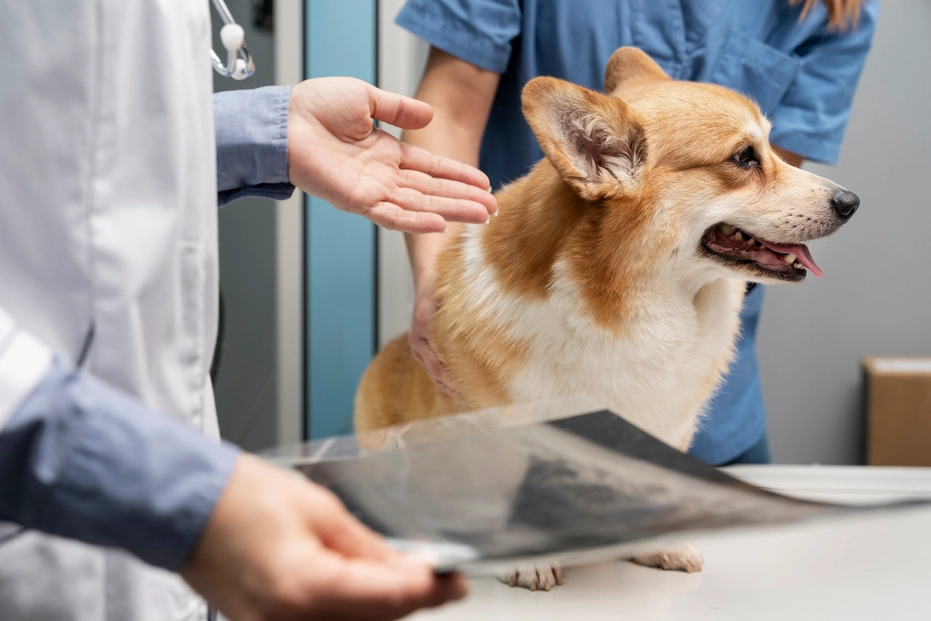
Contents
A spinal injury in dogs can dramatically impact their mobility, particularly in their back legs. Dogs rely heavily on their spinal cord for movement and balance, so even a minor injury to the spine can cause significant issues with walking, running, and overall comfort. Understanding the causes, symptoms, and treatments of spinal injuries in dogs, specifically how they affect the back legs, is crucial for any dog owner. Spinal injuries are often caused by traumatic events, falls, or even age-related deterioration, leading to nerve damage, pain, and sometimes paralysis.
In this blog, we will dive into how spinal injuries can affect your dog’s ability to move, how to recognize the signs early, and the various treatment options available for recovery.
What are Spinal Injuries in Dogs?
Spinal injuries in dogs occur when there’s damage to the spine, affecting the vertebrae, discs, or spinal cord. These injuries can result from trauma such as car accidents, falls, or dog fights. Common symptoms include difficulty moving, limping, or paralysis in the back legs. Immediate veterinary care is crucial to prevent further damage, manage pain, and promote recovery through treatments like surgery, physical therapy, or medication.
What Causes Spinal Injuries in Dogs?
Age-Related Deterioration of Vertebral Discs: As dogs age, the vertebral discs that cushion the bones in the spine naturally begin to deteriorate. This age-related degeneration can lead to conditions like degenerative disc disease (DDD), where the discs lose their elasticity and height, causing the vertebrae to press against each other. This can lead to pain, stiffness, and a reduced range of motion, often affecting the back legs. While this condition is most common in older dogs, it can also cause nerve compression, limiting a dog’s ability to walk or stand.
Falls from Heights: Dogs are naturally curious creatures, and accidents can happen when they fall from heights, such as off furniture or stairs. These falls can cause significant spinal trauma, especially if they land on their back or neck. The impact can lead to vertebral fractures, dislocations, or compression injuries of the spinal cord, which often result in pain, difficulty moving, and sometimes paralysis of the back legs.
Stressful Actions Causing Disc Rupture: Certain stressful actions, such as jumping, running at full speed, or even a sudden twist, can put significant pressure on the spinal discs. In some cases, this pressure causes a disc rupture or herniation, where the soft center of the disc protrudes outward, pressing against the spinal cord. This kind of injury can be quite painful and restrict movement, especially in the back legs. It’s important to prevent strenuous activities for dogs with a history of spinal issues to avoid exacerbating the problem.
Traumatic Injuries
Traumatic spinal injuries often occur due to automobile accidents, gunshots, dog fights, or other high-impact incidents. These accidents can cause significant damage to the spine, including fractures, dislocations, or damage to the spinal nerves. This type of trauma typically results in sudden mobility issues in the back legs, often accompanied by intense pain, swelling, and sometimes paralysis. Dogs may also experience a tucked tail, reluctance to walk, and shivering as signs of distress from such injuries.
Signs of a Spinal Injury in Dogs
Difficulty Moving Normally
One of the most noticeable signs of a spinal injury in a dog is difficulty moving normally. Your dog may appear stiff, and their movement may seem slower or more labored than usual. They may hesitate to stand or take a few steps, or they may try to shift their weight in a way that protects the injured area.
Staggering (Drunken Walking)
A dog with a spinal injury may show signs of staggering or a drunken walking gait. This happens when the spinal injury affects the dog’s ability to maintain proper balance. As a result, they may walk with a wobbling or uncoordinated motion, especially in their back legs. This is often a sign of nerve damage or compression in the spinal cord.
Dragging or Shuffling Rear Legs
If the spinal injury is severe, your dog may begin dragging or shuffling their rear legs. This happens when the nerves controlling the back legs are affected, preventing proper movement and strength. This symptom can worsen over time, especially if the injury goes untreated.
Arching of the Back
Another common sign of a spinal injury in dogs is arching of the back. Dogs may try to compensate for pain or discomfort in their spine by contorting their bodies into an unnatural position. This arching can be particularly noticeable when they are standing, walking, or trying to sit.
Tucked Tail
Dogs with spinal injuries often exhibit a tucked tail position, especially if they are in pain. This is a clear sign of distress or discomfort, as dogs typically express pain by lowering their tail between their legs. The tucked tail often indicates that the injury affects their lower spine or pelvis.
Reluctance to Walk, Play, or Eat
Pain from a spinal injury can lead to a general reluctance to walk, play, or even eat. Dogs in pain often become more withdrawn, which may manifest as a loss of appetite or a sudden decrease in activity. They may avoid walking or refuse to engage in their usual activities due to the discomfort caused by the injury.
Yelping When Handled
Another clear sign of spinal injury is yelping when the dog is handled. If your dog reacts suddenly and loudly when their back, neck, or spine is touched, it’s a strong indication that the area is painful and requires immediate veterinary attention.
For further tips check out Pet Emergency Signs Every Responsible Pet Owner Should Know here.
Veterinary Actions for Spinal Injuries
Emergency Diagnosis and Treatment
When you suspect a spinal injury, seeking veterinary care as soon as possible is crucial. A thorough physical examination and assessment will help your vet determine the extent of the injury. The first step is to stabilize your dog and prevent further damage, which may include placement on a flat board or stretcher for transport to the clinic.
Placement on a Flat Board or Stretcher
Dogs with spinal injuries should be carefully handled to prevent further damage to the spine. Veterinarians typically use a flat board or stretcher to transport the dog to avoid any twisting or bending of the spine. This keeps the spine aligned and reduces the risk of additional damage.
Careful Lifting to Avoid Spinal Twisting
During emergency treatment, careful handling and lifting are essential. The vet will take extra care not to twist or rotate the dog’s spine, which could worsen the injury. Proper lifting helps prevent nerve damage and muscle strain while ensuring the dog is as comfortable as possible.
Surgery for Severe Injuries
In cases of severe spinal injury, surgery may be necessary to relieve pressure on the spinal cord. This could include vertebrae fusion, pinning vertebral bones, or removing ruptured discs. Surgery can help stabilize the spine, relieve pain, and improve the chances of recovery.
Post-Treatment Recovery
- Rest: After treatment, rest is essential for recovery. Your dog may need to stay in the clinic for observation and continued care, depending on the severity of the injury. During this time, they will be kept in a calm environment to avoid stress or further injury.
- Medication: Pain relief medications, including anti-inflammatory drugs, will be prescribed to help manage pain and reduce swelling. These medications are essential in the early stages of recovery to ensure your dog is comfortable and able to rest properly.
- Physical Therapy: Once the dog’s condition stabilizes, physical therapy will play a vital role in rehabilitation. Physical rehabilitation may include controlled exercises, stretching, and other techniques to improve mobility, strengthen muscles, and promote healing in the injured area.
Conclusion
A spinal injury can significantly affect your dog’s back legs and overall mobility. Whether caused by a traumatic event, age-related degeneration, or a sudden fall, recognizing the symptoms early and seeking immediate veterinary care is crucial for a successful recovery. Timely intervention, appropriate treatment options, and a focus on rest and physical therapy can help your dog regain their strength and mobility.
If you suspect your dog has suffered a spinal injury, don’t wait, contact us for immediate care.
At North MS Pet Emergency, our experienced team is here to help your pet recover and regain their quality of life.
FAQs
1. Can a dog recover from a spinal injury?
Yes, dogs can recover from spinal injuries depending on the severity and type of injury. Treatment may include surgery, rest, physical therapy, and medications. Early intervention improves the chances of recovery, but recovery can take time.
2. Can a dog recover from hind leg paralysis?
Recovery from hind leg paralysis in dogs is possible, especially with prompt treatment. Rehabilitation, physical therapy, and sometimes surgery can help regain mobility. The extent of recovery depends on the severity of the spinal injury and nerve damage.
3. How to tell if a dog has a spinal cord injury?
Signs of a spinal cord injury in dogs include sudden hind leg weakness, difficulty moving, uncoordinated movements, inability to stand, pain when touched along the spine, and changes in posture. Immediate veterinary attention is crucial for diagnosis.
4. What is Spinal injury dog back legs treatment?
Treatment for a spinal injury affecting a dog’s back legs may include pain management, anti-inflammatory medications, physical therapy, and surgery (in severe cases). Supportive care, including rest and monitoring, is essential for recovery and mobility improvement.
5. What is a dog’s spinal injury healing time?
Healing time for a dog’s spinal injury depends on the injury’s severity. Minor injuries may take a few weeks, while more severe cases may require several months of recovery. Rehabilitation, rest, and follow-up care speed up healing.




